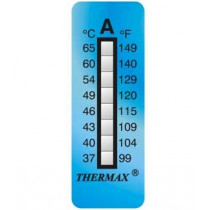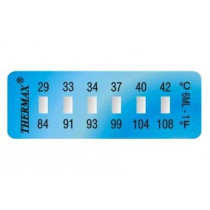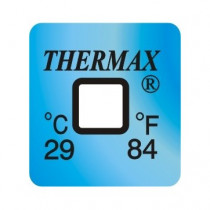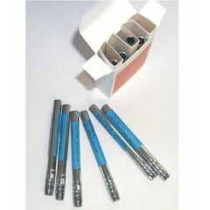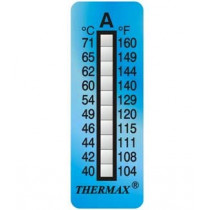No products
Prices do not include tax.
Temperature control in the manufacture of mechanical parts and vulcanized products
The manufacture of parts in the industry often requires the application of thermal processes. The quality of the finished parts depends on the correct application of the temperature needed. It is therefore essential to carry out a suitable temperature control to guarantee a quality product.
In most ovens, whether conventional, static or continuous, with an inflow and outflow of parts, controls are included to monitor their temperature. However, these temperature sensors act on areas of the oven, regardless of the actual temperature the parts are receiving.
Therefore, we can use temperature indicators and heat-sensitive crayons, which show the temperature that the part actually receives since they are applied directly onto it.
Temperature indicators for the manufacture of industrial parts
This product is supplied in packets with 10 thermometers. Irreversible-type temperature indicator with 8 temperature points. This is an adhesive thermometer than can be stuck on any surface or product. The points are marked with temperature in ºC and ºF.
8-level irreversible thermometers (pack 10...15,20 €Adhesive temperature labels with 6 control points are supplied in packets with 10 units.
6-level mini irreversible thermometer...13,96 €Irreversible-type temperature indicator. These temperature labels are adhesive and can be stuck on any surface or product. They change to permanent colour when reaching the marked temperature.
1-temperature irreversible thermometer...25,61 €Thermal pencil for controlling temperatures. These wax-based pencils with heat-sensitive ink allow to mark any surface, which will change colour depending on the temperature.
Heat-sensitive pencil (10 units)119,70 €Irreversible thermometer with de 10 temperature points.. Supplied in packets with 10 units.
10-level irreversible thermometer (pack 10...18,27 €
Issues when controlling the temperature in industrial thermal processes
In the manufacturing of parts, reliable temperature control is essential to ensure that the product goes through the thermal process correctly and, therefore, has the correct features that guarantee the quality of its finishing.
The problem in continuous and static ovens is the use of sensors that monitor the temperature inside the oven itself, but not the temperature of the actual part. Due to the use and wear and tear of the heating resistors, temperature variations inside the oven are quite frequent.
Also, due to wear and tear, the oven temperature sensors can perform faulty readings and need to be replaced or recalibrated.
The use of temperature indicators is a simple solution to this problem.
Temperature indicators for the manufacture of mechanical parts and vulcanized products
Irreversible temperature labels are adhesive sensors that stick to a part and permanently change colour when a specific temperature is reached. When attached to the product, these labels will give us the exact temperature to which the part has been subjected. Additionally, since they are irreversible, at the end of the process we can check if the correct temperature has been reached or not.
Using these temperature indicators makes it possible to detect problems in areas of the oven that are not properly heated, or inaccuracies of the oven’s own temperature sensors due to wear and tear. This allows us to correct the defects and guarantee the quality of the parts. Because these labels are adhesive, they can be removed later on and attached to quality reports.
Temperature crayons
At temperatures above 260 °C, using temperature labels is not possible. However, it is plausible to use temperature crayons for thermal control. These crayons are easy to use, just like the labels. Simply mark the parts to be monitored, and the stroke we make with the crayon will permanently change colour during the process. This will indicate whether or not the right temperature has been reached.Temperature control in the vulcanization of rubber
In the manufacture of parts, one of the processes that require temperature control to guarantee the final product is the vulcanization of rubber, both in the manufacture of tires and the verification of rubber seals.Temperature control in the manufacture of tires
During the manufacture of tyres, several thermal processes require the measurement of the working temperature.
During belt and ply calendering, when the rubber compound is applied to the beads, and when the tire is curing, it is important to control the process temperature.
However, it is during the mixing of the rubber compound where temperature monitoring is critical, as excess heat can damage it. This operation is usually carried out in two stages, the mixing stage, where the temperature ranges between 160 °C and 170 °C, and the final stage, in which the curing materials are added. This final stage cannot exceed 100 °C-110 °C to prevent the material from burning.
Temperature control in the verification of rubber seals
This process requires monitoring and recording of the temperature reached to ensure that the seals will subsequently have the appropriate hardness. The rubber seals must ensure that specific components of the car engine are hermetically sealed to prevent the leakage of the fluids involved in the proper functioning of the engine (brakes, antifreeze, etc.). The process is carried out at 120 °C, and the use of temperature indicators or crayons guarantees the final result.
Temperature recording in the manufacture of mechanical parts: annealing
There are various processes in the industry aimed at changing the properties of metal and, therefore, the characteristics of the part. Annealing is a treatment designed to increase the resistance and elasticity of the part. It is done by eliminating the internal stress that occurred in other processes like tempering.
Temperature control in annealing varies depending on the part and the use that is required. Therefore, parts that need increased hardness, such as tools, are usually subjected to temperatures of 150 °C to 220 °C. In comparison, products that need greater elasticity are subjected to temperatures between 450 °C and 600 °C.
In any of these procedures, using temperature indicators to control the temperature in the manufacture of industrial parts is the most effective way to ensure the final product’s quality.

